Knife grinder – plastics shredder and how to choose suitable machine?
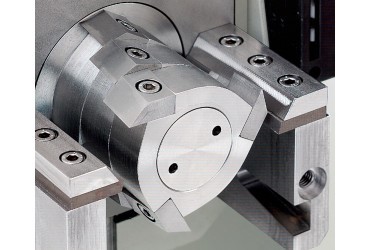
Knife grinder – plastics shredder and how to choose suitable machine?
1. What is knife grinder
2. How does knife grinder work
3. What types of grinders exist
4. What objects and materials are processable
5. What are the advantages and disadvantages of grinding technology
6. What are the most common minuses of the grinders
7. What parameters are important for the right choice of suitable grinder
8. Summary
1. What is knife grinder?
Knife grinder is one of many equipments for reducing of object‘s size, materials, waste and raw materials which we need to be reduced from any reason. We will focus above all on the description of knife grinders for processing of plastics in various forms and with different processing result. These equipments are sometimes incorrectly called as „shredders“, „granulators“, sometimes we even meet with the name „scrapper“, which is from the matter of the construction of course misleading.
2. How does knife grinder work?
Knife grinder for plastics processing has some essential technical characteristics. The base is existence of the flow of processed material into hopper, over grinding chamber of the grinder up to container for processed material. Knife grinder is always equipped with rotating shaft which contains mostly several rotor knives. In the grinding chamber are also stator knives plus the screen with corresponding size. Material goes through the hopper into grinding chamber where is caught by rotor knives and pushed towards stator knives. Adequate part of the material is cut off mechanically. Cutted-off material is cut off again in grinding chamber with rotor knives and grinded into smaller fractions until the material falls through the screen with suitable chosen size. Regrinded material which falls through the screen is collected in the container under the grinding chamber. Material is subsequently transported away from the grinder – mostly with the air flow (to another processing or storing).
3. What types of grinders exist?
As already mentioned, knife grinders are not the only type of grinders or equipments for reducing of material size. If we focus on above all our favorite range of plastics processing, real we can take into consideration even follows eguipments:
- guillotine shears – for initial pre-portioning of large-volume materials. By means of the pressure of one knife against the other one comes to mechanical pre-portioning of the material.
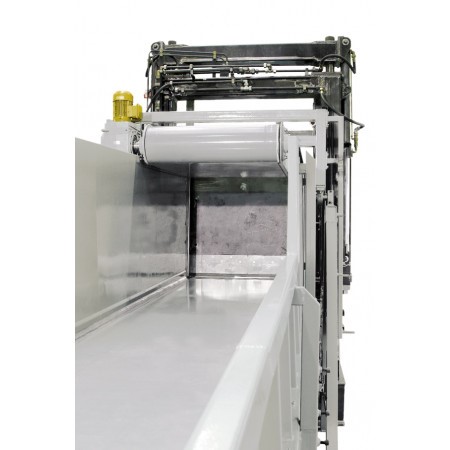
- shredders (pre-shredders) – used mostly for initial pre-portioning of large-volume and masive parts and materials into rough fractions (most often around 20–50 mm) which are then suitable for processing into even smaller fractioncs. For further processing are used for example knife granulators. The reason is that shredders are mostly slow-speeded and force oriented machines with rotating shaft (single- or multi-shaft) and their usage for producing of smaller fractions is uneconomic.
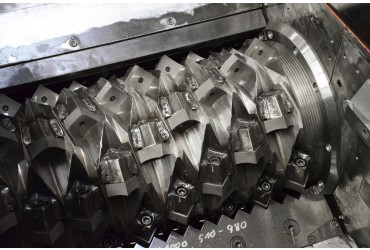
- knife grinders – economical effective suitable solution for processing of non-bulky and non-masive parts or for processing of larger fractions, for example from shredders. The result is the fraction which is closest to the new processed material (mostly in the granulate form of size cca 4 mm).
- tooth grinders – rotor shafts of such grinders are equipped with many same teeth of different shapes. These rotating teeth push processed material towards stator teeth and the material is grinded by cutting into smaller fractions. Tooth grinder are not equipped with the screen, it means the the resulted material fraction is given by the size of individiual teeth.
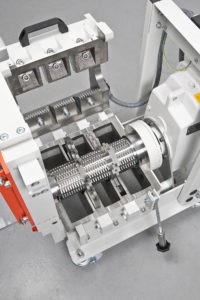
- hammer mills – closest to grinding technology, farthest from cutting technology. The rotor is equipped with pendulous hammers. By rotation of these hammers rises on their ends kinetic energy; by hitting of the hammers to the processed material comes to its pre-portioning into smaller fractions; but this technology is conceivable only by processing of hard and brittle materials and absolutely not suitable for processing of elastic materials.
- disc mills (pulverizers) – eventual next stage for processing of fractions around 4 mm into even finer or dusty material, with fraction size cca to 1 mm. Pulverizers use rotation of one of two grinding discs with fine teething. Material goes from the hopper in the middle of stationary disc. The material is by means of centrifugal force pushed to the edges of the discs, where minimal gap is adjusted. Through this gap fine fractions come out from the grinding chamber and the air transports them on fine screen. Rougher fractions (so called above-screen) come back into the grinding chamber for further processing. Fine fractions (under-screen) are collected for futher processing.
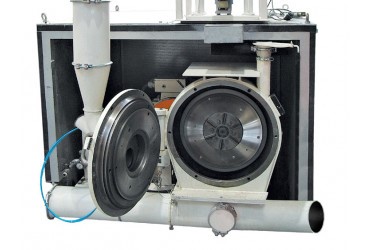
- 4. What objects and materials are processable?
Knife granulators for plastics processing (if we skip the processing of municipal plastic waste) are used mostly by initial production of plastic products by injection, extrusion blowing and extrusion technologies. The purpose is to transform NOK products and process waste (for example sprues and cutoffs) back to useful form of input raw material, most often into recyclate with fraction size cca 4 mm, and to use this material for producing of final product again. Let us talk now about technologies and what kind of waste rises from them:
- plastic injection technology – here we process various defective multishaped parts and by moulds with cold sprue also sprue groups.
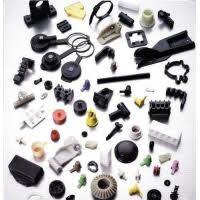
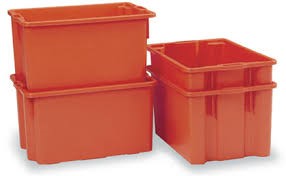
- extrusion blowing – we process defective products and oversprues. Depending on given product it can happen that by shape-complicated parts – for example air conduction by car dash boards – the oversprues can sometimes create even 80 % of material weight from each cycle. So especially this technology is unimaginable without using of knife grinders which are most often integrated directly into in-line process right beside the blowing extruder.
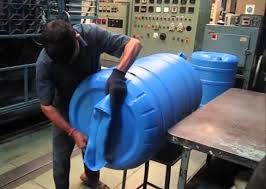
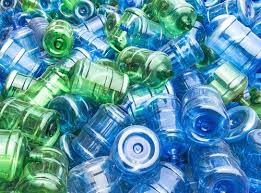
- extrusion – production by means of extrusing of endless profile, pipe, sheet, film and so on. Demanding material entrances before stabilizing of the process, shape-unstable edge cutoffs by production of sheets or cast films make large base for reprocessing of such material, ideally on knife granulator again.
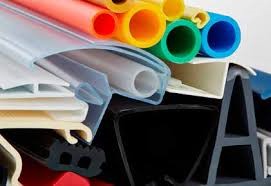
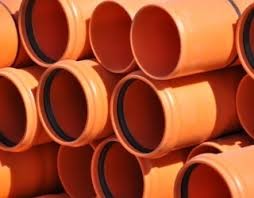
When it comes to kind of materials, it makes sense to process on knife granulators for further use only thermoplastics or thermoplastic elastomers. There are many concrete types of materials and it is not the goal of this article to name them all.
Less meaningful is processing of another materials, as silicons, rubbers, thermosets, resins and other types of reactoplastics. Their reusing in the process is nearly impossible, maximally as some type of filler in limited quantity. The purpose of waste processing from these materials could be only reducing of their size for final disposal.
- 5. What are the advantages and disadvantages of grinding technology?
Grinding technology of processed materials enables further handling with this material and its eventual reusing in production process. If we can process mechanicaly regrined recyclate, then we have valuable material which was stressed only mechanically and which is for sure an advantage. Disadvantage is that the individual fractions are not regular. We have certain dust part here, finer and rougher granulates of irregular shapes. We can illustrate this size character with Gauss curve.
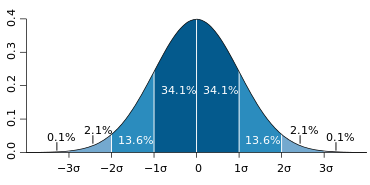
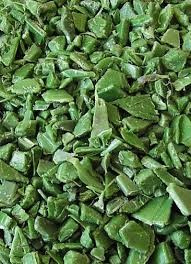
Certain disadvantage of material processing on the grinders (any) is level noise and dustiness. However, nowadays are standardly available solutions like sound-proof enclosures and in case of regularly and correct maintenance also dust elimination.
Let’s return shortly to the possibility of recyclate processing on thermo-regranulation line. It is the next intercomponent in the logistic of material processing. Recyclate from the grinder is thermally overprocessed, homogenisated and extruded again into tiny formations (lenses, small cylinders etc.) which shapes only minimally differs from original input materials. Their bulky and stable dimension properties are on the higher level than the recyclate from the grinder. On the other hand, disadvantage is another energy, space and financial demandingness and another thermal stressing of processed material. However, for some material types is this execution suitable or even necessary.
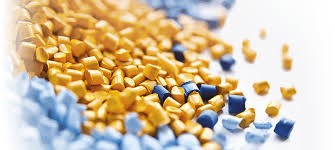
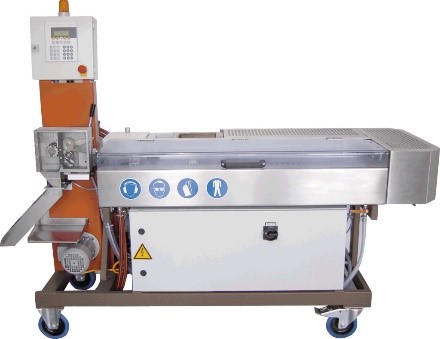
- 6. What are the most common minuses of the grinders?
Any equipment including knife grinders requiers regular maintenance and checks. Among most common production failures belong lack of maintenance of these equipments, overloading of their capacities and their unsuitable using, eventually wrong choice. We can say in generally that above mentioned failures are caused mostly by persons who work with the grinders.
Maintenance – practically almost no one reads the manual or keeps the provisions in it. It concerns mainly the time schedule for check of individual grinder parts, eventually the wrong evaluation of grinder conditions. By knife grinder it is very important to check regularly whether the knives are sharp and screens undamaged. There is one rule – he who sharps, then he grinds. There is also another thing – I sharp more often while less. In opposite case is the grinder unnecessarily stressed (bearings, shafts), we get recyclate with larger dust part and we reach lower hour rates. The same applies for checking of bearings lubrication (lubricate more often while less), checking of mechanical wearing especially of grinding chamber and repairs on time.
Overloading and unsuitable using – the operators change frequently, new operators are not trained enough or not trained at all and many faults happen. Typical is overfilling of the hopper with the material; material stays in the grinder for too long, overheats and the grinding effect is then lower. The similar case is when the operator overdoes the grinder possibilites and tries to grind masive parts. This causes big mechanical swings, or the grinder get stucked and stops. Pushing of the parts in the hopper (for example with wooden sticks) is also incorrect (work safety, contamination of processed material). The material has to fall into grinding chamber on its own, by means of gravitation. It is obvious that before grinding will be removed from the material all impurities, mainly metal parts, which cause significant wearing and damage of the knives and subsequently contaminate material for the next processing. Responsibility and discipline of the operators is absolutelly outright.
Wrong choice – it happens that the grinder is purchased for concrete processing of the material; later the production is changed and the grinder is used for another, unsuitable application. I would recommend here to better sell the grinder and buy some more suitable machine.
- 7. What parameters are important for the right choice of suitable grinder?
Let us focus on the right choice of the knife grinder. We have to clarify some questions:
- what do we want to grind – what part shape, what will be the smallest and the largest size
- from what kind of material is the considered part and if it suitable to be grinded (see reusing of the material, thermoplastics, thermosets, reactoplastics and so on)
- what is expected material output (fraction size), what is expected hour rate
- what will be the logistic of material flow, will it be filled manually or with the robot or conveyor, if the grinder will be used for in-line recyclation or as a central grinder, how and where will be the final recyclate transported – whether to next processing or to storing
- grinder placement – next to other production machines or in separate place, what level of dustiness and noise can be spread into the surroundings
- level of comfort of using of the grinder, what options the customers requires, how is eventual connection of the grinder with another equipments (conveyor belt, metal detector, transport blower, grinder in protective cage right beside the machine etc.)
- if there are any special demands for working place, impact on securing of work safety is always on the first place
- experiences of the customer and the seller with similar applications
- price optimalisation of the solution – there are always several various solutions which are either technically or financially on different level. There is no rule that the more expensive equipment means better solution
- 8. Summary
Knife grinders are essential helpers by processing of technological waste in production. Knife grinders create frame part of grinders, which find their use by processing of plastic materials. They are very often the right solution for whole range of production technologies by which is suitable reprocessing of technological waste. Knife grinders – compared with another grinders – show advantageous rate price/output and with regular and correct maintenance also low operational costs. Despite these facts we find significant differencies in details of technical solutions of individual grinder producers with direct impact on operating ergonomy, reliability, quickness and simplicity of the cleaning. Very important is also initial communication with the seller so the customer would after all choose optimal solution for purchasing of new grinder. Whether the seller, or the producer would be pleased to share their experiences and to offer their know-how.

 Material Dosing and Mixing
Material Dosing and Mixing Products Handling and Automation
Products Handling and Automation

